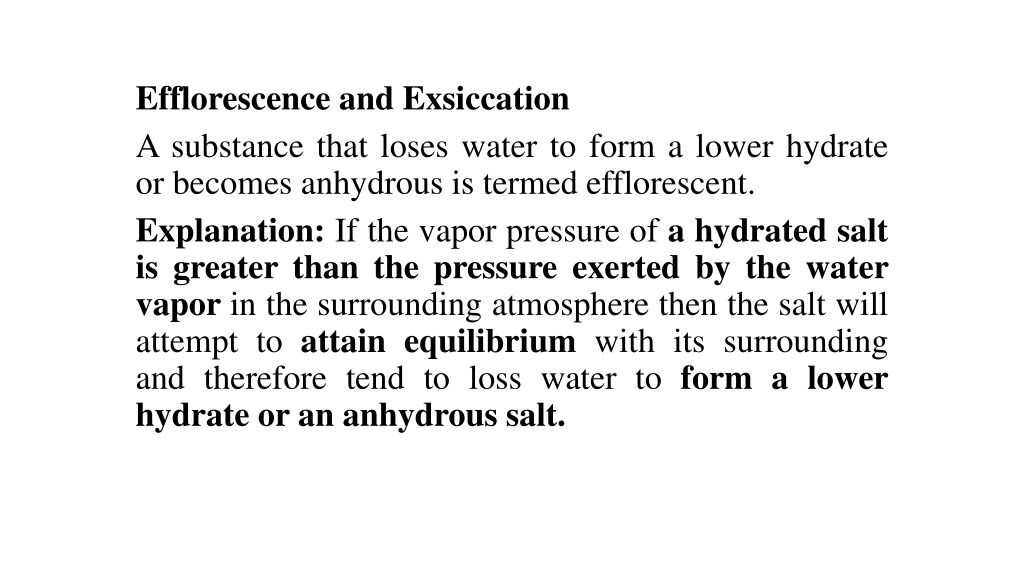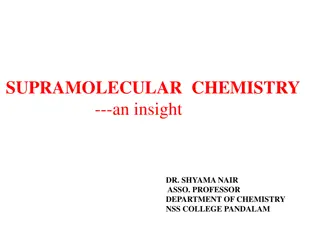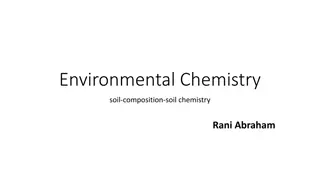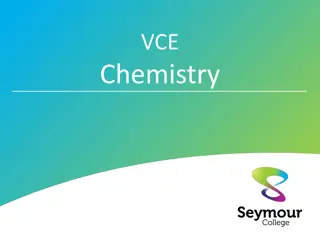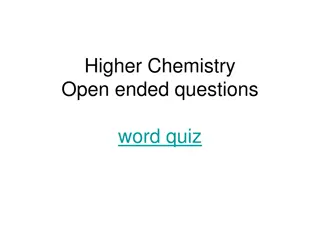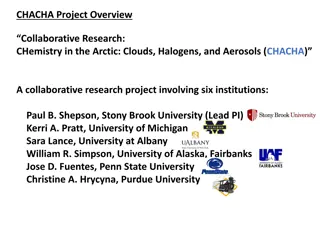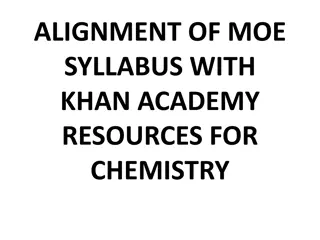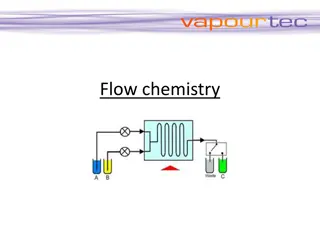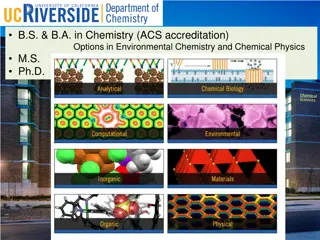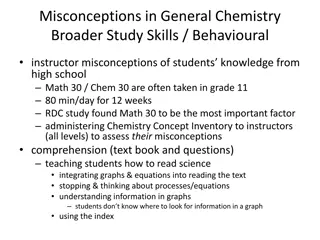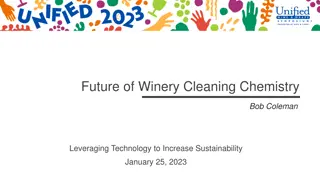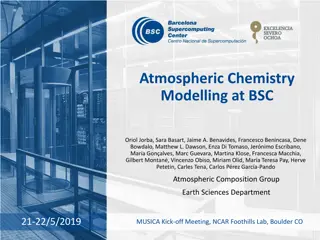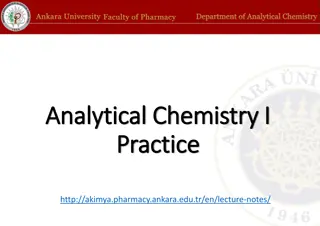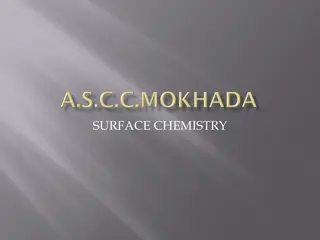Efflorescence and Exsiccation in Chemistry
Efflorescence refers to the process where a substance loses water to form a lower hydrate or becomes anhydrous due to differences in vapor pressures. Hydrates with vapor pressures greater than the atmosphere tend to exhibit efflorescence. The rate of efflorescence increases with temperature. Exsiccation is the process of accelerating efflorescence by increasing temperature to remove water of crystallization from hydrated salts. Examples with sodium carbonate and copper sulfate illustrate these phenomena in chemistry.
Download Presentation

Please find below an Image/Link to download the presentation.
The content on the website is provided AS IS for your information and personal use only. It may not be sold, licensed, or shared on other websites without obtaining consent from the author. Download presentation by click this link. If you encounter any issues during the download, it is possible that the publisher has removed the file from their server.
E N D
Presentation Transcript
Efflorescence and Exsiccation A substance that loses water to form a lower hydrate or becomes anhydrous is termed efflorescent. Explanation: If the vapor pressure of a hydrated salt is greater than the pressure exerted by the water vapor in the surrounding atmosphere then the salt will attempt to attain equilibrium with its surrounding and therefore tend to loss water to form a lower hydrate or an anhydrous salt.
The pressure of water vapor in the atmosphere is about 13.33x102N/m2at 293 K, and therefore hydrates with vapor pressures greater than this will tend to exhibit efflorescence and be unstable, provided that the lower hydrate that is formed still exerts a vapor pressure greater then the surrounding atmosphere.
If this is not so, the water will be taken up from the atmosphere by the lower hydrate as fast as it is formed and the final equilibrium will depend on the rates at which water is lost or taken up by the two hydrates.
For example the behavior of various forms of sodium carbonate may be represented by the following scheme.
Since the vapor pressure exerted by the decahydrate is much greater than that of normal atmosphere it loses water by the process of efflorescence and is converted to the monohydrate. The vapor pressure of the later is still above that of the atmosphere but further apparent loss of water does not occur since the anhydrous salt is rehydrated at a faster rate than dehydration of the monohydrate.
The vapor pressure of hydrated salts, and therefore the rate of efflorescence increases with rise in temperature. The process of accelerating the rate of efflorescence by increasing the temperature in order to remove water of crystallization from a hydrated salt is known as exsiccation.
For example the pentahydrate of copper sulphate may be converted to the trihydrate by heating to 303 K. Two further molecules of water are removed at 373 K to yield the monohydrate and the remaining molecule of water is removed at 473 K to yield the anhydrous salt.
Since the instability that arises from efflorescence is caused by the loss of water vapor. The common method of minimizing such deterioration involves the use of containers that prevent the loss of water vapor.
well-filled The containers with a minimum amount of atmosphere above the efflorescent material and storage in a cool place are also advisable. additional precautions of using
Deliquescence and hygroscopicity A substance that absorbs sufficient moisture from the atmosphere to dissolve itself is deliquescent. Both of these terms are used to indicate that a material takes up water vapor from the atmosphere and is converted to a more hydrated form.
In the case of hygroscopic substances the more hydrated state is still a solid but deliquescence implies the eventual formation of a liquid phase; i.e. a solution In both phenomenon, however the final more hydrated state must still exert a lower vapor pressure than that of the water vapor in the surrounding atmosphere.
If this is not so then the newly formed hydrated state will immediately lose water by effloresces and revert to the initial state. Thus for a liquid phase to be produced by deliquesces it is necessary that the vapor pressure exerted by the saturated solution of the deliquescent material should be less than 13.33x102N/m2
The following scheme showing the behavior of sodium hydroxide may be used as example of deliquescence.
Other hydroxide, sodium lactate and potassium carbonate while examples of hygroscopic substances include exsiccated sodium sulphate, ammonium chloride etc. deliquescent material include potassium
Storage precautions include maintenance of a moisture free atmosphere inside the container . Official monographs usually substances should be containers. A well-filled container atmosphere in the container and therefore further reduces the uptake of moisture by the product. directs in that such well-closed stored limits the volume of
In certain cases, where the product is particularly susceptible to moisture, a drying agent i.e silica gel may be placed inside the container. It may contain an indicator to show when its drying properties are no longer satisfactory.
Anhydrous cobaltous chloride, which is blue, may be used as an indicator, since it is converted to a pink hydrate when the silica gel has adsorbed its maximum amount of water vapor.
Lyophilization Freeze drying (sublimation drying) is a process used to dry extremely heat-sensitive materials. It allows the drying, without excessive damage, of proteins and blood products.
Freeze-drying is the most commonly used procedure. It is essentially a batch process in which water is removed directly from the solid state. It is generally performed in three distinct phases. In the first, the water biopharmaceutical agent is converted to ice. This results in the production of a concentrated frozen macromolecular solid. This freezing step is typically performed in the temperature range of -45 C to -10 C for 2 to 5 hr. in a solution of the
The second stage is referred to as primary drying. This involves the removal of some unfrozen water (15%) and sublimation of ice at -10 C to -40 C for 5 hr to 5 days (this stage is highly variable in time).
The final procedure (secondary drying) involves removal of most of the remainder of the unfrozen water down to 1% to 4% as the temperature is increased from the previous process to 4 C to 50 C for 5 to 15 hr.
The system and shows the triple point at 610 N/m2 (pascal)and at a temperature of 0.0075 . In principle the freeze drying process is simple but the practice is more complicated and the following aspects must be taken into account. figure represents the ice-water-water-vapor
The temperature must be kept below the triple point temperature and it is usual to work in the range -10 to -40 . Similarly the pressure must be below the triple point and pressure between 10 and 30 N/m2are used. Thus the vapors must be removed otherwise the vapor pressure would exceed this value very rapidly.
Stages of the freeze drying process Freezing stage The liquid material is frozen before the application of vacuum to avoid frothing, and several methods are used to produce a large frozen surface.
Shell freezing This is employed for fairly large volumes such as blood products. The bottles are rotated horizontally in a refrigerated bath. The liquid freezes in a thin shell around the inner circumference of the bottle. Freezing is slow and large ice crystals form, which is a drawback of this method as they may damage blood cells (there is a mechanical interaction between ice crystals and cells in which cells are pushed and deformed by the ice crystals). almost slowly and
In vertical spin freezing the bottles are spun individually in a vertical position so that centrifugal force forms a circumferential layer of solution, which is cooled by a blast of cold air. The solution supercools and freezes rapidly, with the formation of small ice crystals. Small ice crystals are preferred for products such as blood and blood plasma.
Centrifugal evaporative freezing This is a similar method, where the solution is spun in small containers within a centrifuge. This prevents foaming when a vacuum is applied. The vacuum causes boiling at room temperature and this removes so much latent heat that the solution cools quickly and snap (rapid/sudden) freezes.
About 20% of the water is removed prior to freeze drying and there is no need for refrigeration. Ampoules are usually frozen in this way, a number being spun in a horizontal angled position in a special centrifuge head so that the liquid is thrown outwards and freezes as a wedge.
Shelf freezing The solution can be frozen in the dryer itself. Trays of bulk material or small containers such as antibiotic vials can be frozen by this method.
Vacuum application stage The containers and the frozen material must be connected to a vacuum source sufficient to drop the pressure below the triple point and remove the large volumes of low-pressure vapour formed during drying. Commonly a number of bottles or vials are attached to individual outlets of a manifold, which is connected to a vacuum.
Sublimation stage Heat of sublimation must be supplied. Under these conditions the ice slowly sublimes, leaving a porous solid which still contains about 0.5% moisture after primary drying.
Primary drying Primary drying can reduce the moisture content of a freeze-dried solid to around 0.5%. Further reduction can be effected by secondary drying. During the primary drying, the latent heat of sublimation must be provided removed. and the vapour
Heat transfer Heat transfer is critical: insufficient heat input prolongs the process, which is already slow, and excess heat will cause melting. Prefrozen bottles - of blood, for example - are placed in individually heated cylinders, or are connected to a manifold when heat can be taken from the atmosphere.
Shelf-frozen materials are heated from the drier shelf, whereas ampoules may be left on the centrifuge head or may be placed on a manifold, but in either case heat from the atmosphere is sufficient. In all cases the heat transfer must be controlled, as only about 5 W m-2 K-1 is needed and overheating will lead to melting.
Vapour removal The vapour formed must be continually removed to avoid a pressure rise that would stop sublimation. To reduce the pressure sufficiently it is necessary to use efficient vacuum pumps. On the small scale, vapour is absorbed by a desiccant such as phosphorus pentoxide, or is cooled in a small condenser with solid carbon dioxide.
On the large scale vapour is commonly removed by pumping, but the pumps must be of large capacity and not affected by moisture.
Rate of drying The rate of drying in freeze drying is very slow, the ice being removed at a rate of about only 1 mm depth per hour. Any attempt to increase sublimation involves raising the heat transfer coefficient and would only lead to melting.
Secondary drying The removal of residual moisture at the end of primary drying is performed by raising the temperature of the solid to as high as 50 or 60 C. A high temperature is permissible for many materials because the small amount of moisture remaining is not sufficient to cause spoilage.
Packaging Attention must be paid to packaging freeze-dried products to ensure protection Containers should be closed without contacting the atmosphere, if possible, and ampoules, for example, are sealed on the manifold while still under vacuum. Otherwise, the closing must be carried out under controlled atmospheric conditions. from moisture.
Advantages As a result of the character of the process, freeze drying has certain special advantages: 1. Drying takes place at very low temperatures, so that enzyme action is inhibited decomposition, particularly hydrolysis, is minimized. and chemical
2. The solution is frozen such that the final dry product is a network of solid occupying the same volume as the original solution. Thus, the product is light and porous. 3. The porous form of the product gives ready solubility.
4. There is no concentration of the solution prior to drying. Hence, salts do not concentrate and denature proteins, as occurs with other drying methods. 5. As the process takes place under high vacuum there is little contact with air, and oxidation is minimized.
Disadvantages There are two main disadvantages of freeze drying: 1. The porosity, ready solubility and complete dryness yield a very hygroscopic product. Unless products are dried in their final container and sealed in situ, packaging requires special conditions.
2. The process is very slow and uses complicated plant, which is very expensive. It is not a general method of drying, therefore, but is limited to certain types of valuable products which, because of their heat sensitivity, cannot be dried by any other means.
Uses of freeze drying The method is used for products that cannot be dried by any other heat method. These include biological products, for example some antibiotics, blood products, vaccines (such as BCG, yellow fever, smallpox), enzyme preparations (such as hyaluronidase) and microbiological cultures. The latter enables specific microbiological species and strains to be stored for long periods with a viability of about 10% on reconstitution.
Elutriation It is a process of sizing particles by means of an upward current of fluid, usually water or air. The process is the reverse of gravity sedimentation.
Elutriation is a technique in which the fluid flows in an opposite direction to the sedimentation movement, so that in gravitational elutriators particles move vertically downwards while the fluid travels vertically upwards. If the upward velocity of the fluid is less than the settling velocity of the particle, sedimentation occurs and the particle moves downwards against the flow of fluid.
Conversely, if the settling velocity of the particle is less than the upward fluid velocity, the particle moves upwards with the fluid flow. Therefore, in the case of elutriation, particles are divided into different size fractions depending on the velocity of the fluid.
